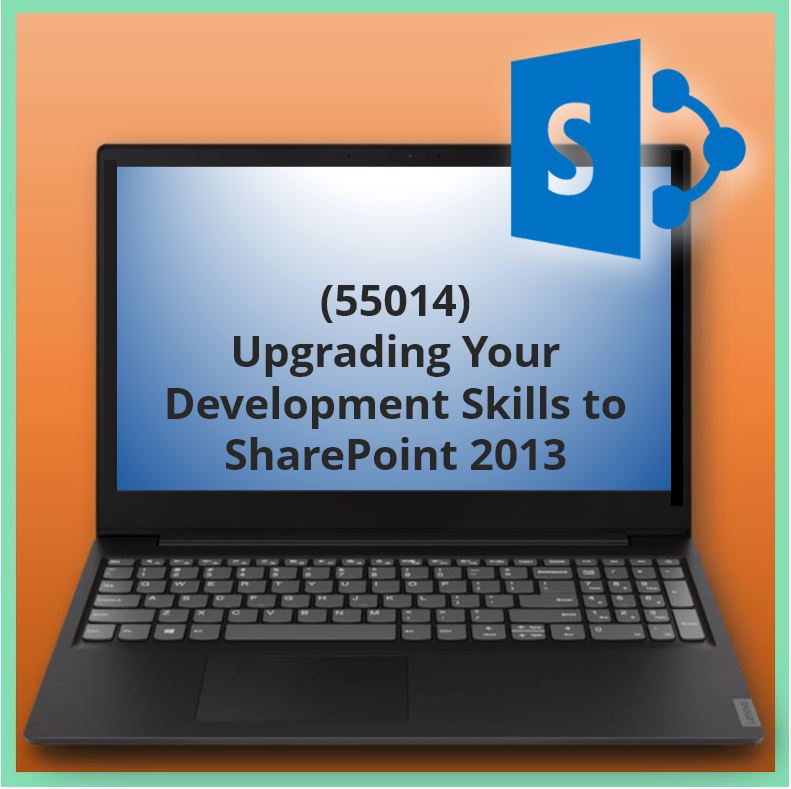Aangeboden leervormen

Upgrading Your Development Skills to SharePoint 2013 (55014)
This course will teach you all the new development changes that were made to SharePoint 2013 including .NET 4.0, Visual Studio 2012, Mobility, Workflow 4.0, OData, OAuth, Claims Authentication, SharePoint AppStore and the new Service Applications (Machine Translation and PowerPoint Automation).
Audience profile
This course is intended for anyone interested in getting an introductory look at the new development features of SharePoint 2013.
At course completion
After completing this course, students will be able to:
• Describe Object Model changes, Mobility Features, OData, OAuth and Translation Services. Work with Visual Studio 2012 SharePoint Templates and build SharePoint 2013 AppStore Apps.
Voor wie
Software ontwikkelaars
Programma
Module 1: OverviewA simple introduction module.
Lessons
• n/a
After completing this module, students will be able to:
• Understand your course, classroom, classmates, facility and instructor.
Module 2: SharePoint 2013 UI and ASP.NET 4.0
Description: In this module we take a look at the new features introduced in SharePoint 2013 from a UI perspective and explore some of the features of ASP.NET 4.0 that we can now take advantage of.
Lessons
• ASP.NET 4.0
• New SharePoint UI Features
Lab : ASPNET 4
• Explore 2013 UI Changes
• ASP.NET 4.0
• Managed Navigation
• Cross Site Publishing
• Image Renditions
• Embedded Code
Lab : SharePoint 2013 Features
• Explore 2013 UI Changes
• ASP.NET 4.0
• Managed Navigation
• Cross Site Publishing
• Image Renditions
• Embedded Code
After completing this module, students will be able to:
• Describe the new UI features of SharePoint 2013 including Follow, Drag and Drop, SkyDrive Pro, Composed Looks, Newsfeeds and OneNote
• Understand the differences between ASP.NET 2.0 and ASP.NET 4.0
• Understand the differences between the .NET Runtime and Frameworks
• Deploy Managed Navigation
• Work with Cross-Site publishing
• Work with Image-Renditions
• Utilize the new Embedded Code Feature
Module 3: SharePoint 2013 and Visual Studio 2012
Description: In this module we are going to take a look at the new SharePoint 2013 project templates and their many improved features that can be installed with Visual Studio 2012.
Lessons
• Visual Studio 2012
• SharePoint 2013 Templates
Lab : Visual Studio 2012
• Explore Visual Studio 2012
• Explore SharePoint Project Templates
• Explore Server Explorer
• Packaging and Deployment Tools
After completing this module, students will be able to:
• Be familiar with the new Visual Studio 2012 interface
• What SharePoint project templates exists in Visual Studio 2012
• How to utilize the deployment capabilities of the templates
• What new project templates and items are included in SharePoint project templates
Module 4: Object Model Changes
Description: In this module we are going to explore the various changes made to the SharePoint Object Model APIs, the new Distributed Cache Serviceclasses, eDiscovery and SharePoint Education.
Lessons
• Working With Distributed Cache Service
• eDiscovery
• SharePoint Education
• Object Model Changes
Lab : Exploring Server Object Model Changes
• Explore new Assemblies, Namespaces, Classes
• Using .NET Reflector with SharePoint
• Enable & Explore Upgraded Developer Dashboard
• Learn to use the new eDiscovery APIs
• Create Discovery Center
• Create a Case
• Create Discovery Sets
• Create Queries
• Learn to use the new SharePoint Education APIs
• Setup and Configure SharePoint Education Web Application
• Create a SharePoint Education Course Site
• Create and Assign Assignments
• Create Quizzes
Lab : Using the New Developer Dashboard
• Explore new Assemblies, Namespaces, Classes
• Using .NET Reflector with SharePoint
• Enable & Explore Upgraded Developer Dashboard
• Learn to use the new eDiscovery APIs
• Create Discovery Center
• Create a Case
• Create Discovery Sets
• Create Queries
• Learn to use the new SharePoint Education APIs
• Setup and Configure SharePoint Education Web Application
• Create a SharePoint Education Course Site
• Create and Assign Assignments
• Create Quizzes
Lab : Programming eDiscovery
• Explore new Assemblies, Namespaces, Classes
• Using .NET Reflector with SharePoint
• Enable & Explore Upgraded Developer Dashboard
• Learn to use the new eDiscovery APIs
• Create Discovery Center
• Create a Case
• Create Discovery Sets
• Create Queries
• Learn to use the new SharePoint Education APIs
• Setup and Configure SharePoint Education Web Application
• Create a SharePoint Education Course Site
• Create and Assign Assignments
• Create Quizzes
Lab : SharePoint Education
• Explore new Assemblies, Namespaces, Classes
• Using .NET Reflector with SharePoint
• Enable & Explore Upgraded Developer Dashboard
• Learn to use the new eDiscovery APIs
• Create Discovery Center
• Create a Case
• Create Discovery Sets
• Create Queries
• Learn to use the new SharePoint Education APIs
• Setup and Configure SharePoint Education Web Application
• Create a SharePoint Education Course Site
• Create and Assign Assignments
• Create Quizzes
After completing this module, students will be able to:
• Understand the SharePoint Object Model Changes
• Understand what new assemblies, namespaces and classes are available
• Understand how to configure and work with Distributed Cache Service
• Understand the features of SharePoint Education
• Understand how to work with eDiscovery
Module 5: SharePoint REST
Description: In this module we are going to take a look at the new Representational State Transfer (REST) features of SharePoint 2013.
Lessons
• REST
Lab : REST
• Utilize Old REST Services
• Explore REST Service References
• Utilize New REST Services
• REST List Service Calls (PUT, GET, MERGE)
• REST UserProfile Service
• REST Social Service
• REST Search Service
• REST Excel Service
After completing this module, students will be able to:
• Describe the REST Architecture in SharePoint 2013
• Describe and use the available REST EndPoints
• How to build REST-ful queries
• How to program to REST-ful Services
Module 6: Client Object Model
Description: In this module we are going to take a look at the new features of the Client Object Models in SharePoint 2013.
Lessons
• Minimal Download Strategy
• Client Object Model
Lab : Client Object Model
• Explore Client Object Model
• Utilize Client Object Model (.NET)
• UserProfilesSocial CSOM
• Taxonomy CSOM
• Publishing CSOM
• Working with Remote Event Receivers
• Explore JavaScript Object Model
• Working with Workflows
• Programming Minimal Download Strategy (MDS)
Lab : JavaScript Object Model
• Explore Client Object Model
• Utilize Client Object Model (.NET)
• UserProfilesSocial CSOM
• Taxonomy CSOM
• Publishing CSOM
• Working with Remote Event Receivers
• Explore JavaScript Object Model
• Working with Workflows
• Programming Minimal Download Strategy (MDS)
Lab : Minimal Download Strategy (MDS)
• Explore Client Object Model
• Utilize Client Object Model (.NET)
• UserProfilesSocial CSOM
• Taxonomy CSOM
• Publishing CSOM
• Working with Remote Event Receivers
• Explore JavaScript Object Model
• Working with Workflows
• Programming Minimal Download Strategy (MDS)
After completing this module, students will be able to:
• How to use the New Client Object Model Features
• How to use the New JavaScript Object Model Features
• How to use the new CSOM endpoints (UserProfile, Taxonomy, Publishing)
• How to implement Remote Event Receivers
Module 7: Mobility
Description: In this module we are going to explore the new Mobility features provided in SharePoint 2013. You will also see how to utilize the new Push notifications as well as the Location and Map APIs.Lessons
• SharePoint 2013 Mobility Features
Lab : Mobility Programming on SharePoint 2013
• Explore Built-In Mobility Features
• Mobility (Android)
• Mobility (Blackberry)
• Creating Mobile Panels
• Adding a GeoLocation Field
• Configuring Bing Maps
• Install SharePoint Windows Phone SDK
• Building Mobile Location Applications
• Use SharePoint Windows Phone Templates
• Develop Apps using Push Notifications (MPNS)
• Configure Push Notifications (SMS)
Lab : Mobility Push Notifications
• Explore Built-In Mobility Features
• Mobility (Android)
• Mobility (Blackberry)
• Creating Mobile Panels
• Adding a GeoLocation Field
• Configuring Bing Maps
• Install SharePoint Windows Phone SDK
• Building Mobile Location Applications
• Use SharePoint Windows Phone Templates
• Develop Apps using Push Notifications (MPNS)
• Configure Push Notifications (SMS)
Lab : Location and Maps APIs
• Explore Built-In Mobility Features
• Mobility (Android)
• Mobility (Blackberry)
• Creating Mobile Panels
• Adding a GeoLocation Field
• Configuring Bing Maps
• Install SharePoint Windows Phone SDK
• Building Mobile Location Applications
• Use SharePoint Windows Phone Templates
• Develop Apps using Push Notifications (MPNS)
• Configure Push Notifications (SMS)
After completing this module, students will be able to:
• Understand SharePoint's Mobility Support
• How to build your own Mobility Applications with Visual Studio 2012
• How to work with Push Notifications
• How to work with Location and Maps
Module 8: Workflow 4.0
Description: In this module we are going to take a look at implementing workflows with the new Visual Studio 2012 templates and with SharePoint Designer 2013. We will also explore the new architecture of cloud based Azure Workflows.
Lessons
• Workflows in SharePoint 2013
Lab : Creating Simple 2013 Workflows
• Create a custom workflow using SharePoint Designer 2013
• Configure Windows Azure Workflows
• Work with Stages
• Work with Loops
• Utilize new SharePoint activities
• Create a workflow using Visio 2013
• Create a custom workflow using Visual Studio
Lab : Creating Visio-based Workflows
• Create a custom workflow using SharePoint Designer 2013
• Configure Windows Azure Workflows
• Work with Stages
• Work with Loops
• Utilize new SharePoint activities
• Create a workflow using Visio 2013
• Create a custom workflow using Visual Studio
Lab : Creating Azure Workflows
• Create a custom workflow using SharePoint Designer 2013
• Configure Windows Azure Workflows
• Work with Stages
• Work with Loops
• Utilize new SharePoint activities
• Create a workflow using Visio 2013
• Create a custom workflow using Visual Studio
After completing this module, students will be able to:
• How to utilize the new Windows Workflow 4.0 in SharePoint 2013
• How to build Windows Azure based Workflows
• Use the new Visual Studio 2012Workflow templates
Module 9: SharePoint Apps
Description: In this module we are going to explore how to develop, publish and deploy SharePoint private and public Applications.Lessons
• SharePoint 2013 Private Apps
• SharePoint 2013 Public Apps
Lab : Creating Private SharePoint Apps
• Configuring App for SharePoint Hosting
• Creating an App for SharePoint (SharePoint hosted)
• Deploying App For SharePoint (Site-Based)
• Deploying App For SharePoint (App Catalog-Based)
• Requesting Apps for SharePoint From SharePoint AppStore
• Creating a Seller Dashboard account
• Create and Publish AppStore SharePoint App
• Create SharePoint Online Account
• Create and Deploy Auto-hosted (Azure) SharePoint App
Lab : Creating Azure SharePoint Apps
• Configuring App for SharePoint Hosting
• Creating an App for SharePoint (SharePoint hosted)
• Deploying App For SharePoint (Site-Based)
• Deploying App For SharePoint (App Catalog-Based)
• Requesting Apps for SharePoint From SharePoint AppStore
• Creating a Seller Dashboard account
• Create and Publish AppStore SharePoint App
• Create SharePoint Online Account
• Create and Deploy Auto-hosted (Azure) SharePoint App
Lab : Creating Public SharePoint AppStore Apps
• Configuring App for SharePoint Hosting
• Creating an App for SharePoint (SharePoint hosted)
• Deploying App For SharePoint (Site-Based)
• Deploying App For SharePoint (App Catalog-Based)
• Requesting Apps for SharePoint From SharePoint AppStore
• Creating a Seller Dashboard account
• Create and Publish AppStore SharePoint App
• Create SharePoint Online Account
• Create and Deploy Auto-hosted (Azure) SharePoint App
After completing this module, students will be able to:
• How to deploy SharePoint Apps in various ways
• How to create anAppCatalog
• How to build and publish a SharePoint AppStore Application
• How to download and install a SharePoint AppStore Application
Module 10: OAuth, S2S and Claims
Description: In this module we are going to take a look at the new support for OAuth 2.0 and look at new features of claims based authentication support in SharePoint 2013.
Lessons
• Working with Claims Authentication
• Working with OAuth 2.0 and S2S
Lab : Creating Server-To-Server(S2S) Applications
• Programming with SharePoint 2013 High Trust Apps
• Working with Application Permissions
• Programming with SharePoint 2013 OAuth 2.0
• Claims to Windows Identity Service
• Building a Claims Web Part
• Integrating ADFS 2.0 and SharePoint 2013
Lab : Claims Based Auth
• Programming with SharePoint 2013 High Trust Apps
• Working with Application Permissions
• Programming with SharePoint 2013 OAuth 2.0
• Claims to Windows Identity Service
• Building a Claims Web Part
• Integrating ADFS 2.0 and SharePoint 2013
Lab : Creating OAuth Applications
• Programming with SharePoint 2013 High Trust Apps
• Working with Application Permissions
• Programming with SharePoint 2013 OAuth 2.0
• Claims to Windows Identity Service
• Building a Claims Web Part
• Integrating ADFS 2.0 and SharePoint 2013
After completing this module, students will be able to:
• How to work with OAuth 2.0 in SharePoint 2013
• How to work with Claims Based Authentication
• How to build a claims web part
• How to integrate ADFS 2.0 with SharePoint 2013
Module 11: Programming 2013 Service Applications
Description: In this module we are going to take a look at the new Machine Translation and PowerPoint Automation Services then review the not-widely used, but should have been, Word Automation Services.
Lessons
• Working with PowerPoint Automation Services
• Working with Word Automation Services
• Working with Machine Translation Services
Lab : Programming Translation Services
• Programming Translation Services (Server Object Model)
• Programming Translation Services (Client Object Model)
• Programming Translation Services (REST)
• Integrating Office Web Apps with Translation Services
• Programming PowerPoint Automation Services
• Convert PPT to PPTS
• Convert PPT to PDF
• Install Office XML SDK 2.0
• Programming Word Automation Services
• Updating Table of Contents
• Converting to PDF
• Merging Word Documents
Lab : Programming PowerPoint Automation
• Programming Translation Services (Server Object Model)
• Programming Translation Services (Client Object Model)
• Programming Translation Services (REST)
• Integrating Office Web Apps with Translation Services
• Programming PowerPoint Automation Services
• Convert PPT to PPTS
• Convert PPT to PDF
• Install Office XML SDK 2.0
• Programming Word Automation Services
• Updating Table of Contents
• Converting to PDF
• Merging Word Documents
Lab : Programming Word Automation
• Programming Translation Services (Server Object Model)
• Programming Translation Services (Client Object Model)
• Programming Translation Services (REST)
• Integrating Office Web Apps with Translation Services
• Programming PowerPoint Automation Services
• Convert PPT to PPTS
• Convert PPT to PDF
• Install Office XML SDK 2.0
• Programming Word Automation Services
• Updating Table of Contents
• Converting to PDF
• Merging Word Documents
After completing this module, students will be able to:
• Develop Machine Translation applications
• Develop PowerPoint Automation Applications
• Develop Word Automation Applications
• How to use Office XML SDK 2.0
Voorkennis
Before attending this course, students must have:
• .NET Object Oriented programming and understanding of basic development tasks in SharePoint.
Examen
NVT
Duur training
Open Leercentrum: 5 dagen








